Abstract
Fas antigen (CD95) is a membrane-associated molecule that mediates apoptotic cell death and may play a role in the induction and maintenance of T cell tolerance. To elucidate the involvement of Fas antigen in human autoimmune diseases, we analysed Fas antigen expression by peripheral T cells from patients with SLE and rheumatoid arthritis (RA), using three-colour flow cytometry. Both CD4+ and CD8+ T cells from SLE patients expressed Fas antigen in a higher density than did these cells from healthy donors and from RA patients. Enhancement of Fas antigen density was noted in Fas+CD45RO+ memory T cells from SLE patients. More remarkably, a significant expression of Fas antigen was observed in CD45RO- naive T cells from SLE patients. CD4+CD45RO- T cells from SLE patients co-expressed Fas antigen and early to intermediate activation antigens such as CD25 and CD71, and late activation antigen HLA-DR in only FashiCD4+ naive T cells. Such up-regulation of Fas antigen expression in SLE patients seems to be clinically meaningful, because mean fluorescence intensity (MFI) of Fas antigen on CD4+ T cell subsets inversely correlates with the absolute size of CD4+ T cell subsets in peripheral blood of SLE patients. These results suggest that T cells with increased Fas antigen expression may be highly susceptible to apoptotic cell death, in vivo. A putative mechanism for lymphopenia in SLE patients is discussed.
Full text
PDF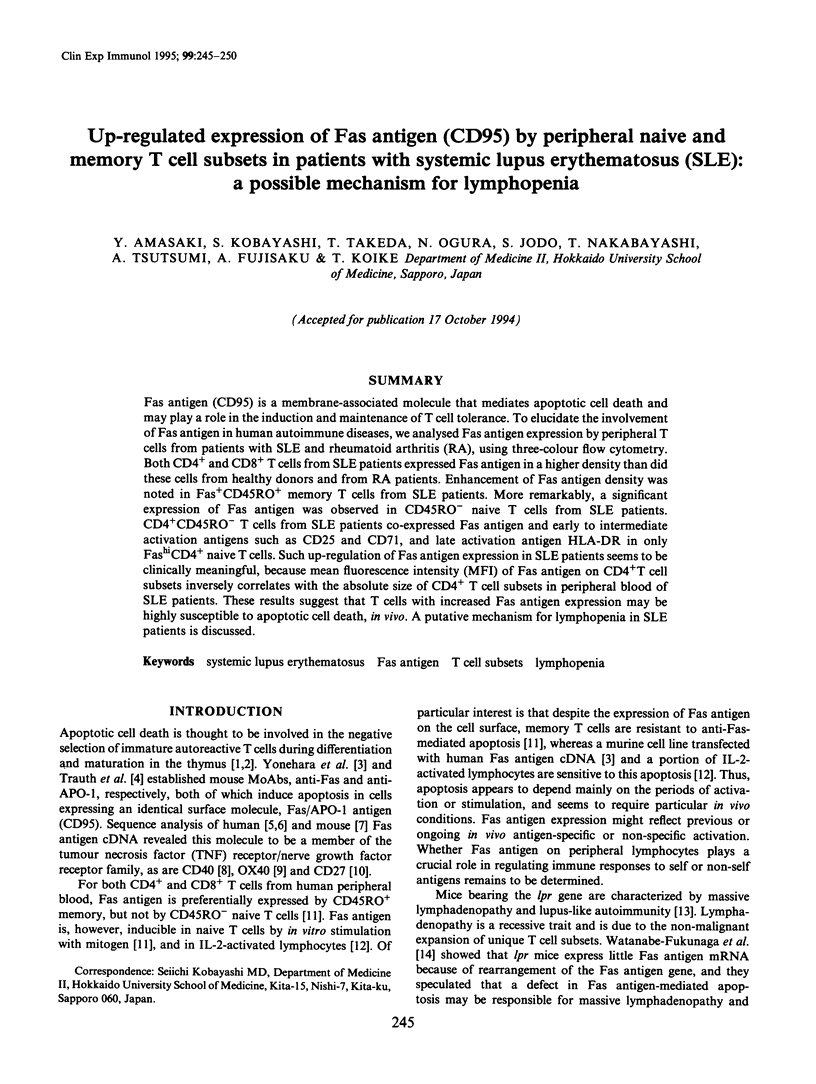
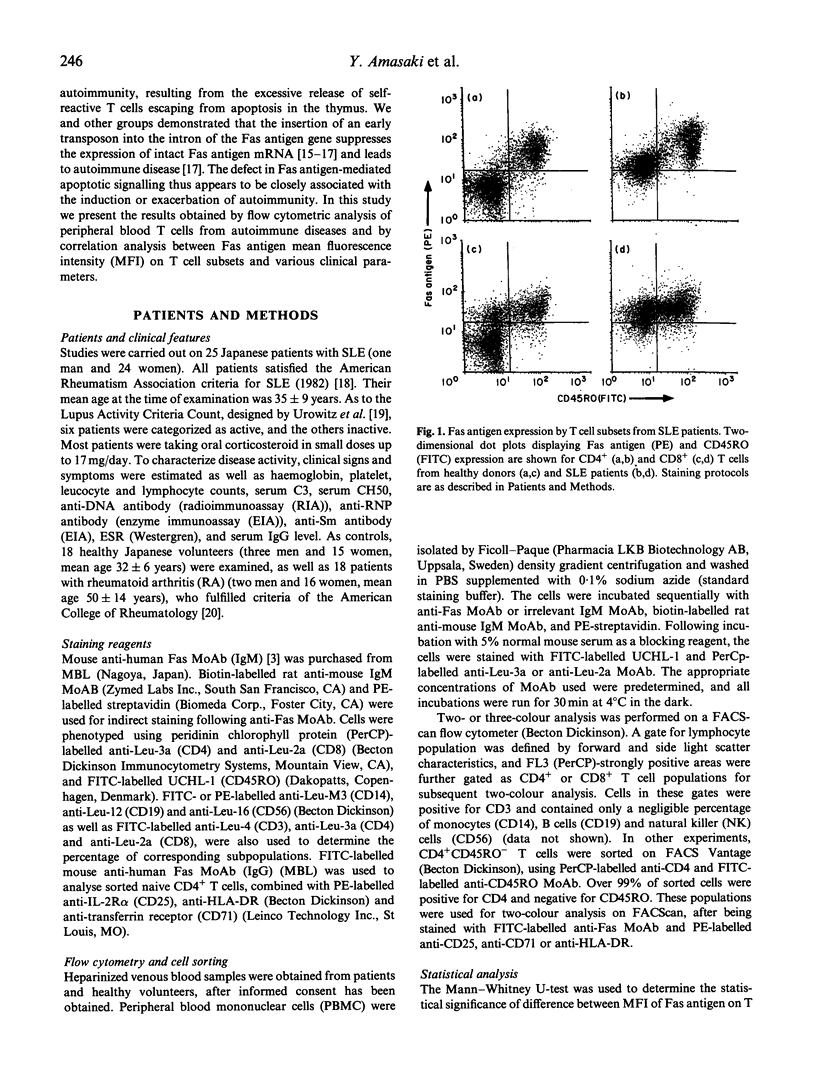
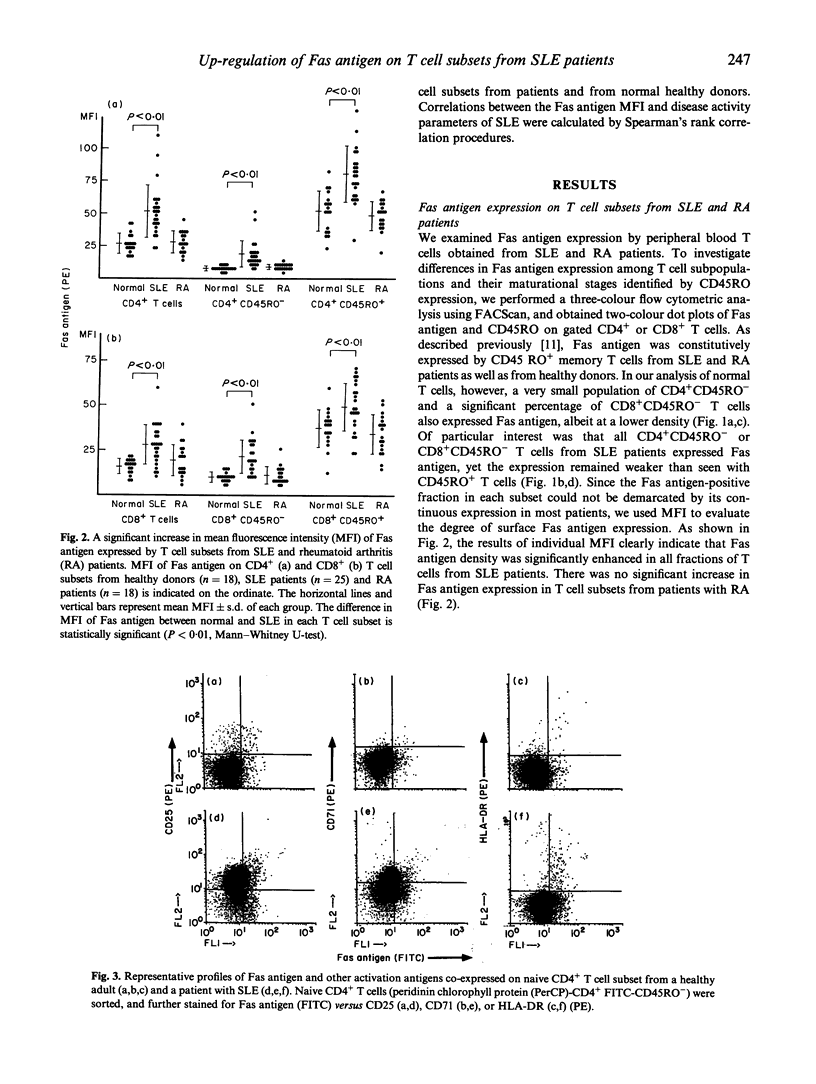
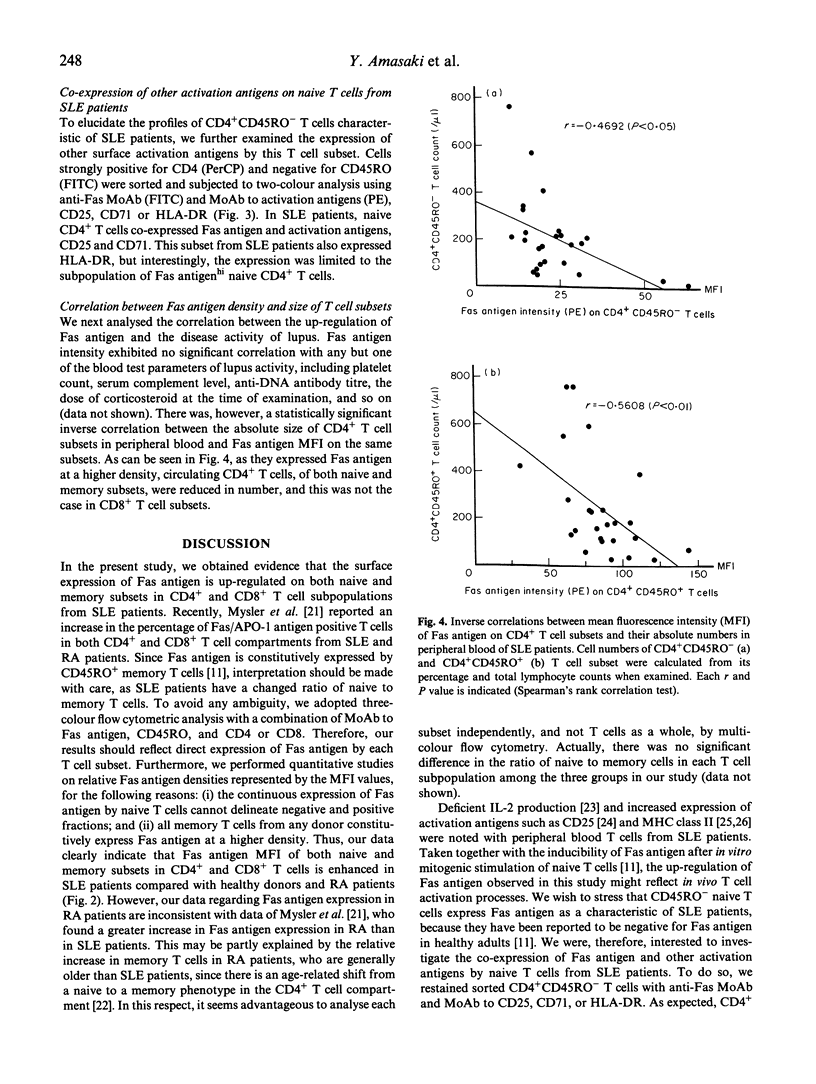
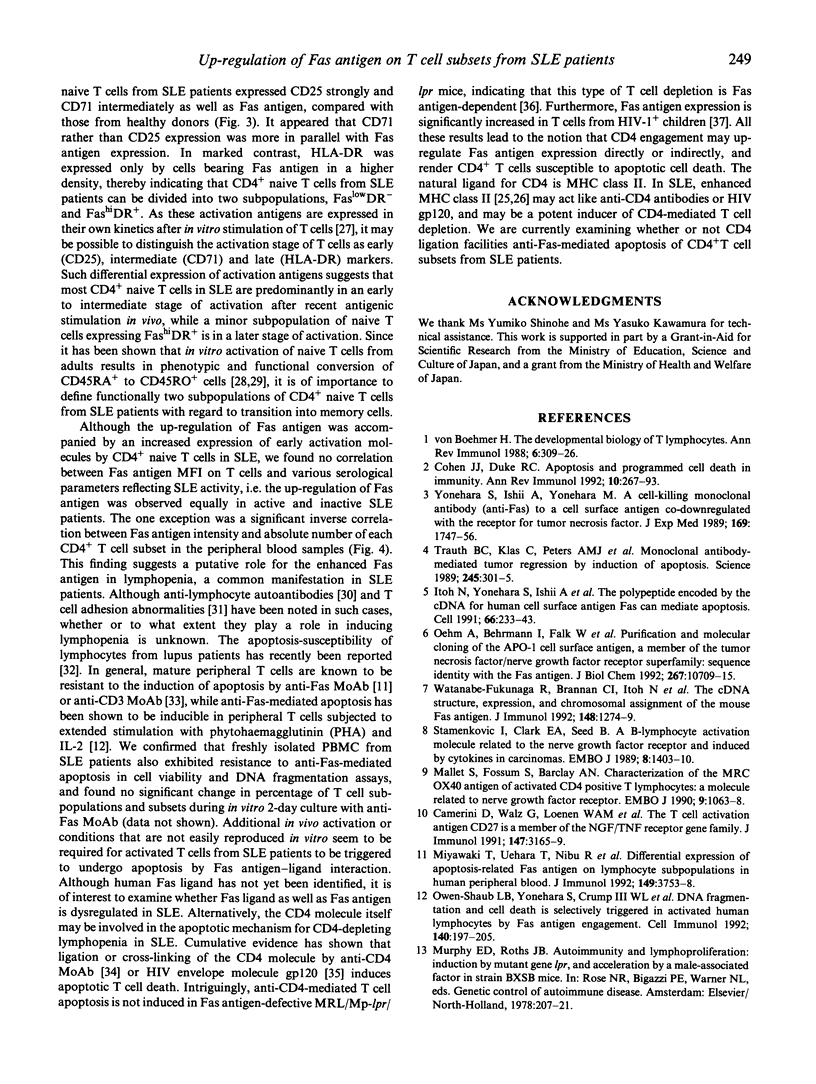
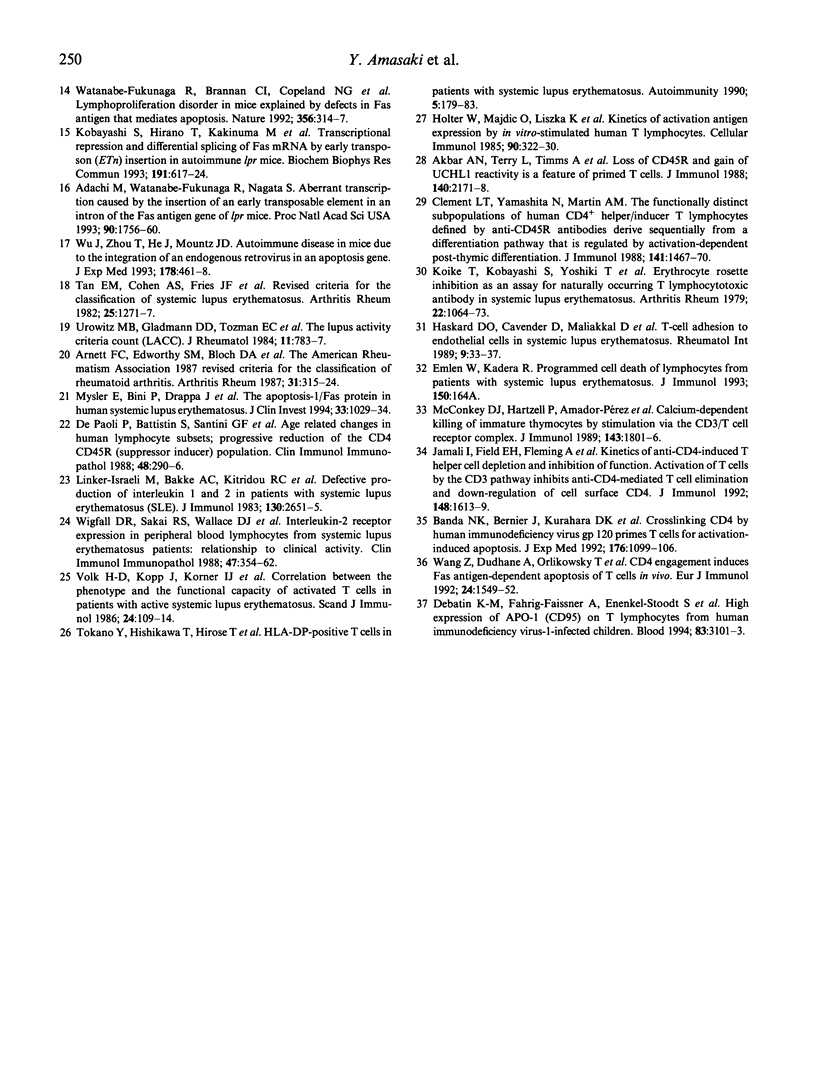
Selected References
These references are in PubMed. This may not be the complete list of references from this article.
- Adachi M., Watanabe-Fukunaga R., Nagata S. Aberrant transcription caused by the insertion of an early transposable element in an intron of the Fas antigen gene of lpr mice. Proc Natl Acad Sci U S A. 1993 Mar 1;90(5):1756–1760. doi: 10.1073/pnas.90.5.1756. [DOI] [PMC free article] [PubMed] [Google Scholar]
- Akbar A. N., Terry L., Timms A., Beverley P. C., Janossy G. Loss of CD45R and gain of UCHL1 reactivity is a feature of primed T cells. J Immunol. 1988 Apr 1;140(7):2171–2178. [PubMed] [Google Scholar]
- Arnett F. C., Edworthy S. M., Bloch D. A., McShane D. J., Fries J. F., Cooper N. S., Healey L. A., Kaplan S. R., Liang M. H., Luthra H. S. The American Rheumatism Association 1987 revised criteria for the classification of rheumatoid arthritis. Arthritis Rheum. 1988 Mar;31(3):315–324. doi: 10.1002/art.1780310302. [DOI] [PubMed] [Google Scholar]
- Banda N. K., Bernier J., Kurahara D. K., Kurrle R., Haigwood N., Sekaly R. P., Finkel T. H. Crosslinking CD4 by human immunodeficiency virus gp120 primes T cells for activation-induced apoptosis. J Exp Med. 1992 Oct 1;176(4):1099–1106. doi: 10.1084/jem.176.4.1099. [DOI] [PMC free article] [PubMed] [Google Scholar]
- Camerini D., Walz G., Loenen W. A., Borst J., Seed B. The T cell activation antigen CD27 is a member of the nerve growth factor/tumor necrosis factor receptor gene family. J Immunol. 1991 Nov 1;147(9):3165–3169. [PubMed] [Google Scholar]
- Cohen J. J., Duke R. C., Fadok V. A., Sellins K. S. Apoptosis and programmed cell death in immunity. Annu Rev Immunol. 1992;10:267–293. doi: 10.1146/annurev.iy.10.040192.001411. [DOI] [PubMed] [Google Scholar]
- De Paoli P., Battistin S., Santini G. F. Age-related changes in human lymphocyte subsets: progressive reduction of the CD4 CD45R (suppressor inducer) population. Clin Immunol Immunopathol. 1988 Sep;48(3):290–296. doi: 10.1016/0090-1229(88)90022-0. [DOI] [PubMed] [Google Scholar]
- Debatin K. M., Fahrig-Faissner A., Enenkel-Stoodt S., Kreuz W., Benner A., Krammer P. H. High expression of APO-1 (CD95) on T lymphocytes from human immunodeficiency virus-1-infected children. Blood. 1994 May 15;83(10):3101–3103. [PubMed] [Google Scholar]
- Haskard D. O., Cavender D., Maliakkal D., Ziff M. T-cell adhesion to endothelial cells in systemic lupus erythematosis. Rheumatol Int. 1989;9(1):33–37. doi: 10.1007/BF00270287. [DOI] [PubMed] [Google Scholar]
- Holter W., Majdic O., Liszka K., Stockinger H., Knapp W. Kinetics of activation antigen expression by in vitro-stimulated human T lymphocytes. Cell Immunol. 1985 Feb;90(2):322–330. doi: 10.1016/0008-8749(85)90197-2. [DOI] [PubMed] [Google Scholar]
- Itoh N., Yonehara S., Ishii A., Yonehara M., Mizushima S., Sameshima M., Hase A., Seto Y., Nagata S. The polypeptide encoded by the cDNA for human cell surface antigen Fas can mediate apoptosis. Cell. 1991 Jul 26;66(2):233–243. doi: 10.1016/0092-8674(91)90614-5. [DOI] [PubMed] [Google Scholar]
- Jamali I., Field E. H., Fleming A., Cowdery J. S. Kinetics of anti-CD4-induced T helper cell depletion and inhibition of function. Activation of T cells by the CD3 pathway inhibits anti-CD4-mediated T cell elimination and down-regulation of cell surface CD4. J Immunol. 1992 Mar 15;148(6):1613–1619. [PubMed] [Google Scholar]
- Kobayashi S., Hirano T., Kakinuma M., Uede T. Transcriptional repression and differential splicing of Fas mRNA by early transposon (ETn) insertion in autoimmune lpr mice. Biochem Biophys Res Commun. 1993 Mar 15;191(2):617–624. doi: 10.1006/bbrc.1993.1262. [DOI] [PubMed] [Google Scholar]
- Koike T., Kobayashi S., Yoshiki T., Itoh T., Shirai T. Erythrocyte rosette inhibition as an assay for naturally occurring T lymphocytotoxic antibody in systemic lupus erythematosus. Arthritis Rheum. 1979 Oct;22(10):1064–1073. doi: 10.1002/art.1780221004. [DOI] [PubMed] [Google Scholar]
- Linker-Israeli M., Bakke A. C., Kitridou R. C., Gendler S., Gillis S., Horwitz D. A. Defective production of interleukin 1 and interleukin 2 in patients with systemic lupus erythematosus (SLE). J Immunol. 1983 Jun;130(6):2651–2655. [PubMed] [Google Scholar]
- Mallett S., Fossum S., Barclay A. N. Characterization of the MRC OX40 antigen of activated CD4 positive T lymphocytes--a molecule related to nerve growth factor receptor. EMBO J. 1990 Apr;9(4):1063–1068. doi: 10.1002/j.1460-2075.1990.tb08211.x. [DOI] [PMC free article] [PubMed] [Google Scholar]
- McConkey D. J., Hartzell P., Amador-Pérez J. F., Orrenius S., Jondal M. Calcium-dependent killing of immature thymocytes by stimulation via the CD3/T cell receptor complex. J Immunol. 1989 Sep 15;143(6):1801–1806. [PubMed] [Google Scholar]
- Miyawaki T., Uehara T., Nibu R., Tsuji T., Yachie A., Yonehara S., Taniguchi N. Differential expression of apoptosis-related Fas antigen on lymphocyte subpopulations in human peripheral blood. J Immunol. 1992 Dec 1;149(11):3753–3758. [PubMed] [Google Scholar]
- Mysler E., Bini P., Drappa J., Ramos P., Friedman S. M., Krammer P. H., Elkon K. B. The apoptosis-1/Fas protein in human systemic lupus erythematosus. J Clin Invest. 1994 Mar;93(3):1029–1034. doi: 10.1172/JCI117051. [DOI] [PMC free article] [PubMed] [Google Scholar]
- Oehm A., Behrmann I., Falk W., Pawlita M., Maier G., Klas C., Li-Weber M., Richards S., Dhein J., Trauth B. C. Purification and molecular cloning of the APO-1 cell surface antigen, a member of the tumor necrosis factor/nerve growth factor receptor superfamily. Sequence identity with the Fas antigen. J Biol Chem. 1992 May 25;267(15):10709–10715. [PubMed] [Google Scholar]
- Owen-Schaub L. B., Yonehara S., Crump W. L., 3rd, Grimm E. A. DNA fragmentation and cell death is selectively triggered in activated human lymphocytes by Fas antigen engagement. Cell Immunol. 1992 Mar;140(1):197–205. doi: 10.1016/0008-8749(92)90187-t. [DOI] [PubMed] [Google Scholar]
- Stamenkovic I., Clark E. A., Seed B. A B-lymphocyte activation molecule related to the nerve growth factor receptor and induced by cytokines in carcinomas. EMBO J. 1989 May;8(5):1403–1410. doi: 10.1002/j.1460-2075.1989.tb03521.x. [DOI] [PMC free article] [PubMed] [Google Scholar]
- Tan E. M., Cohen A. S., Fries J. F., Masi A. T., McShane D. J., Rothfield N. F., Schaller J. G., Talal N., Winchester R. J. The 1982 revised criteria for the classification of systemic lupus erythematosus. Arthritis Rheum. 1982 Nov;25(11):1271–1277. doi: 10.1002/art.1780251101. [DOI] [PubMed] [Google Scholar]
- Tokano Y., Hishikawa T., Hirose T., Sekigawa I., Hashimoto H., Okumura K., Hirose S. HLA-DP-positive T cells in patients with systemic lupus erythematosus. Autoimmunity. 1990;5(3):179–183. doi: 10.3109/08916939009002976. [DOI] [PubMed] [Google Scholar]
- Trauth B. C., Klas C., Peters A. M., Matzku S., Möller P., Falk W., Debatin K. M., Krammer P. H. Monoclonal antibody-mediated tumor regression by induction of apoptosis. Science. 1989 Jul 21;245(4915):301–305. doi: 10.1126/science.2787530. [DOI] [PubMed] [Google Scholar]
- Urowitz M. B., Gladman D. D., Tozman E. C., Goldsmith C. H. The lupus activity criteria count (LACC). J Rheumatol. 1984 Dec;11(6):783–787. [PubMed] [Google Scholar]
- Volk H. D., Kopp J., Körner I. J., Jahn S., Grunow R., Barthelmes H., Fiebig H. Correlation between the phenotype and the functional capacity of activated T cells in patients with active systemic lupus erythematosus. Scand J Immunol. 1986 Jul;24(1):109–114. doi: 10.1111/j.1365-3083.1986.tb02074.x. [DOI] [PubMed] [Google Scholar]
- Wang Z. Q., Dudhane A., Orlikowsky T., Clarke K., Li X., Darzynkiewicz Z., Hoffmann M. K. CD4 engagement induces Fas antigen-dependent apoptosis of T cells in vivo. Eur J Immunol. 1994 Jul;24(7):1549–1552. doi: 10.1002/eji.1830240714. [DOI] [PubMed] [Google Scholar]
- Watanabe-Fukunaga R., Brannan C. I., Copeland N. G., Jenkins N. A., Nagata S. Lymphoproliferation disorder in mice explained by defects in Fas antigen that mediates apoptosis. Nature. 1992 Mar 26;356(6367):314–317. doi: 10.1038/356314a0. [DOI] [PubMed] [Google Scholar]
- Watanabe-Fukunaga R., Brannan C. I., Itoh N., Yonehara S., Copeland N. G., Jenkins N. A., Nagata S. The cDNA structure, expression, and chromosomal assignment of the mouse Fas antigen. J Immunol. 1992 Feb 15;148(4):1274–1279. [PubMed] [Google Scholar]
- Wigfall D. R., Sakai R. S., Wallace D. J., Jordan S. C. Interleukin-2 receptor expression in peripheral blood lymphocytes from systemic lupus erythematosus patients: relationship to clinical activity. Clin Immunol Immunopathol. 1988 Jun;47(3):354–362. doi: 10.1016/s0090-1229(88)80012-6. [DOI] [PubMed] [Google Scholar]
- Wu J., Zhou T., He J., Mountz J. D. Autoimmune disease in mice due to integration of an endogenous retrovirus in an apoptosis gene. J Exp Med. 1993 Aug 1;178(2):461–468. doi: 10.1084/jem.178.2.461. [DOI] [PMC free article] [PubMed] [Google Scholar]
- Yonehara S., Ishii A., Yonehara M. A cell-killing monoclonal antibody (anti-Fas) to a cell surface antigen co-downregulated with the receptor of tumor necrosis factor. J Exp Med. 1989 May 1;169(5):1747–1756. doi: 10.1084/jem.169.5.1747. [DOI] [PMC free article] [PubMed] [Google Scholar]
- von Boehmer H. The developmental biology of T lymphocytes. Annu Rev Immunol. 1988;6:309–326. doi: 10.1146/annurev.iy.06.040188.001521. [DOI] [PubMed] [Google Scholar]


